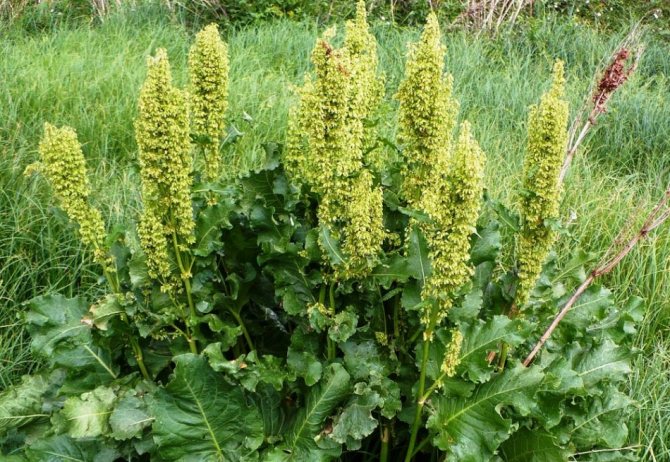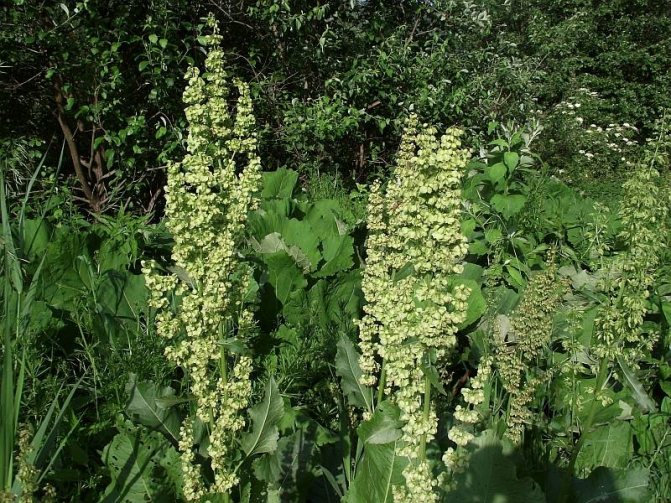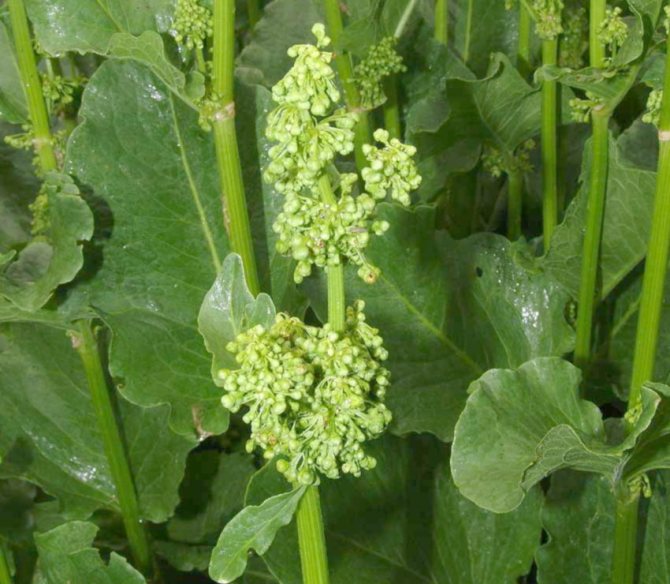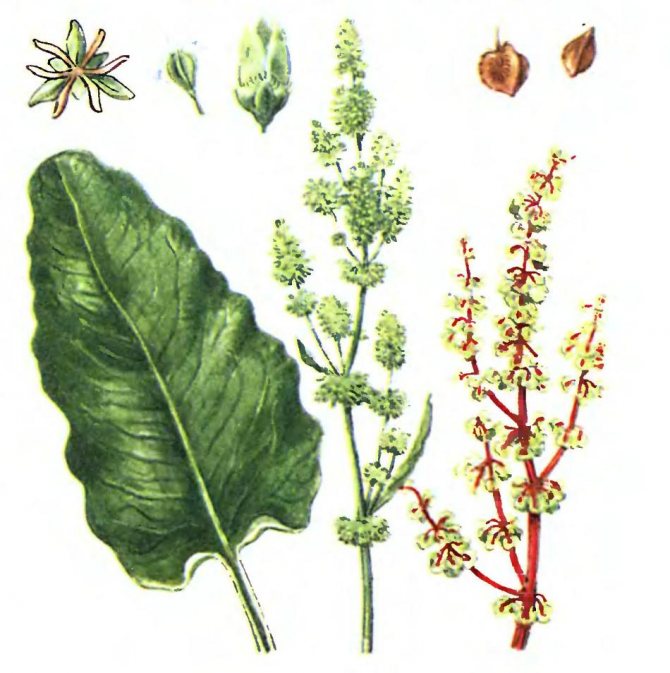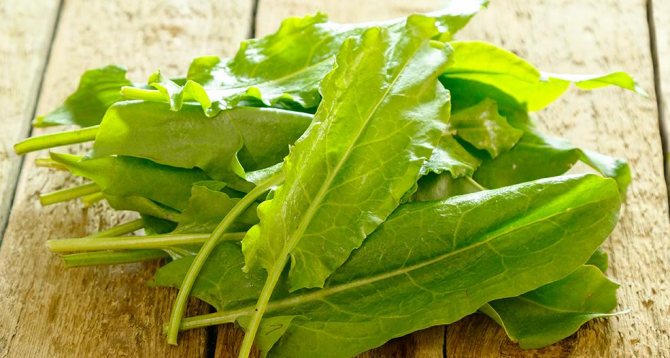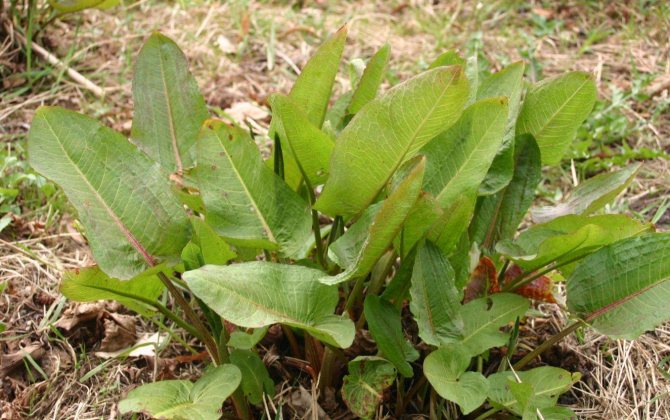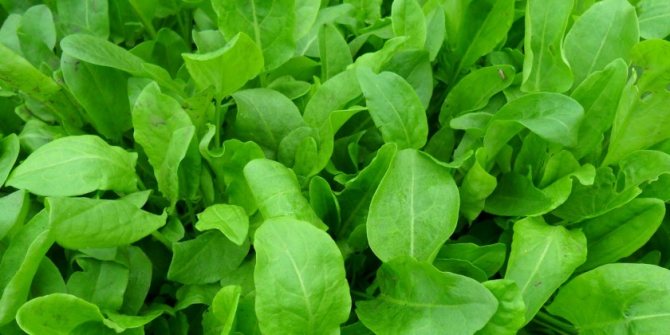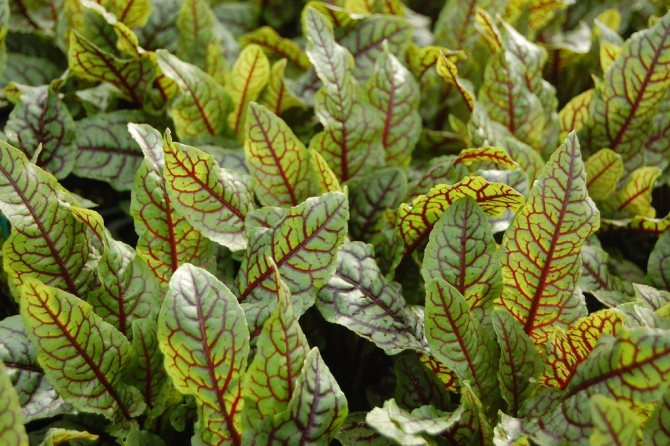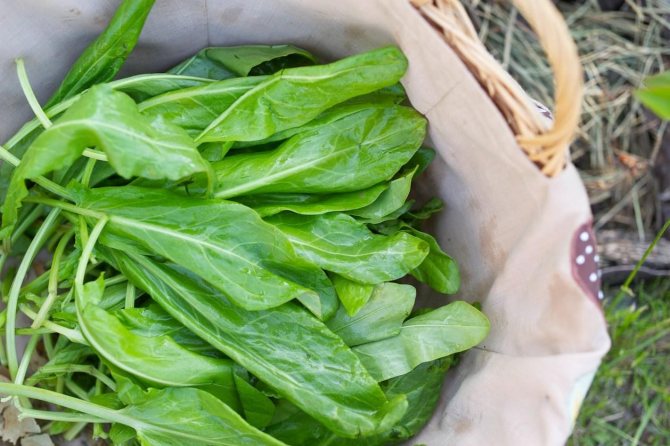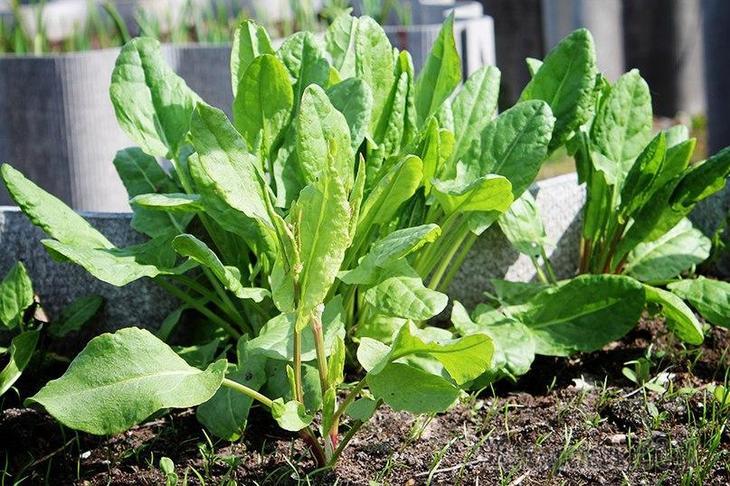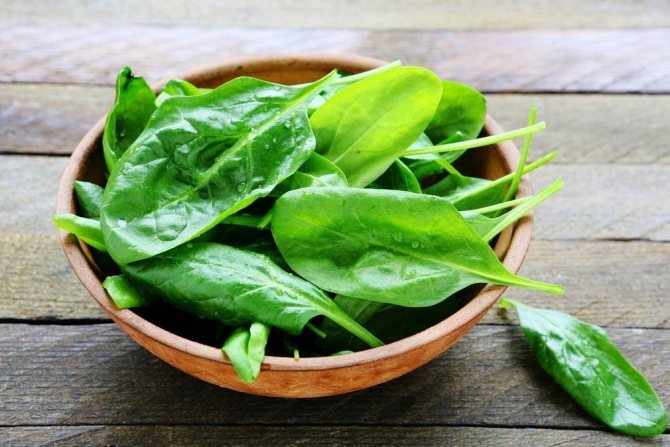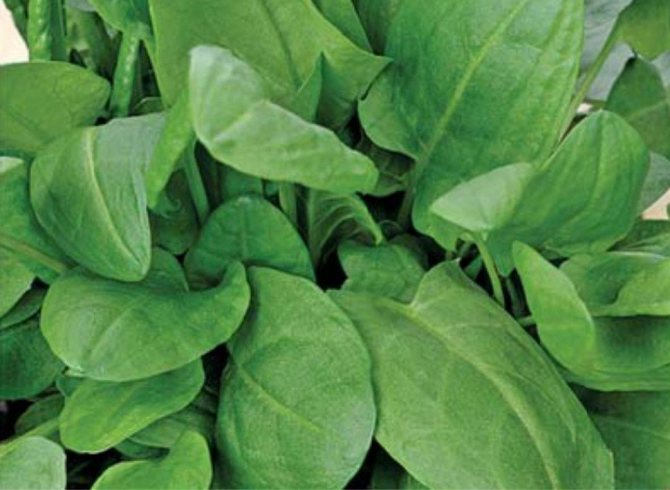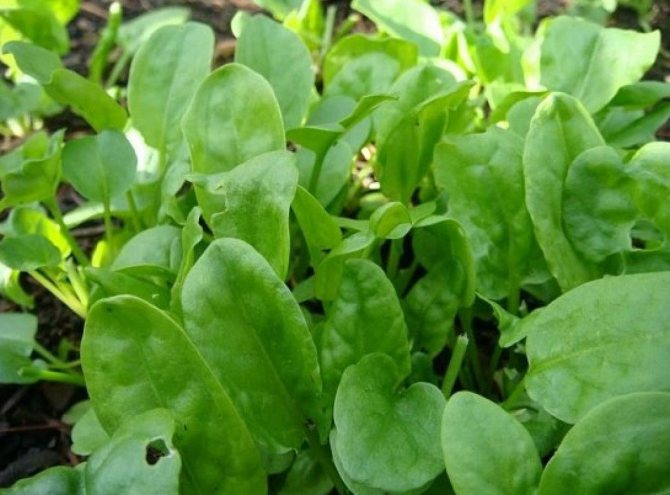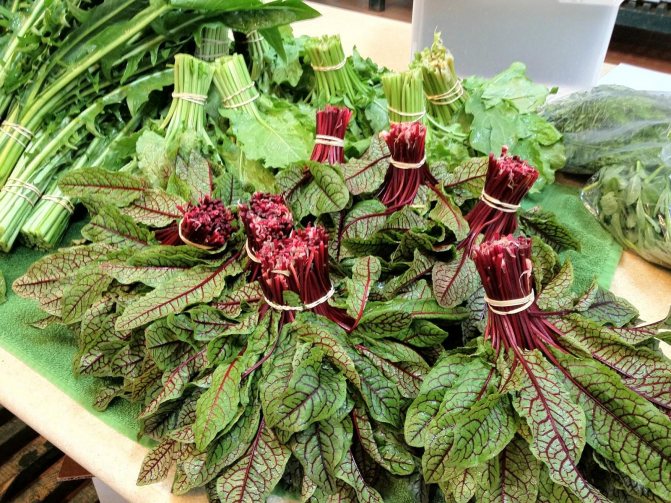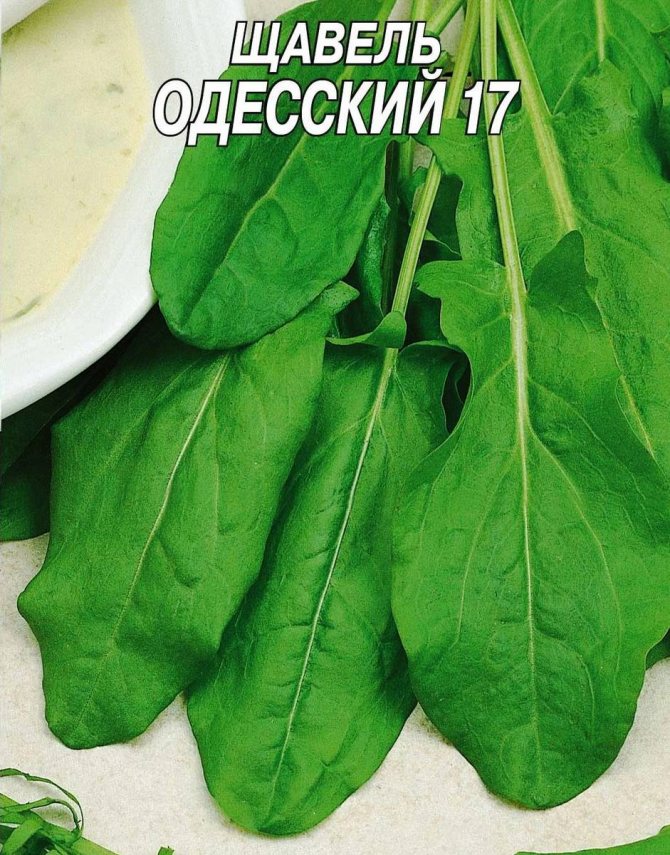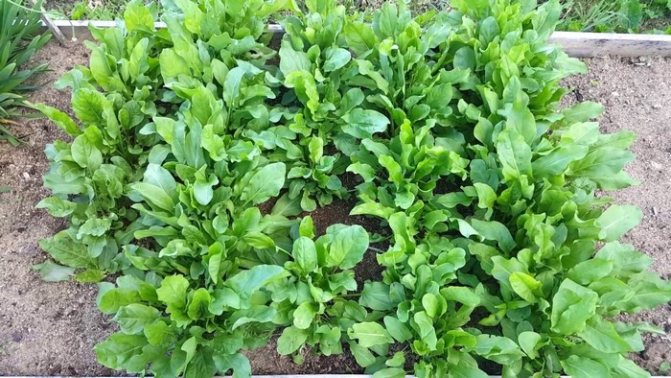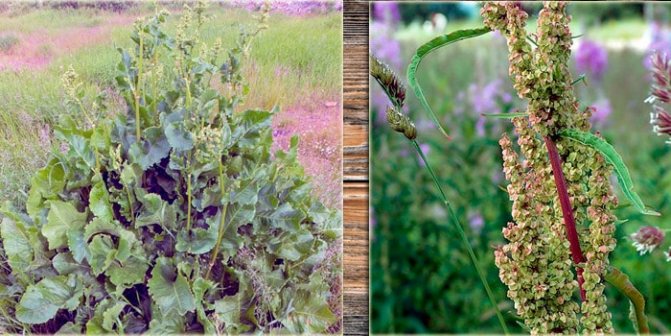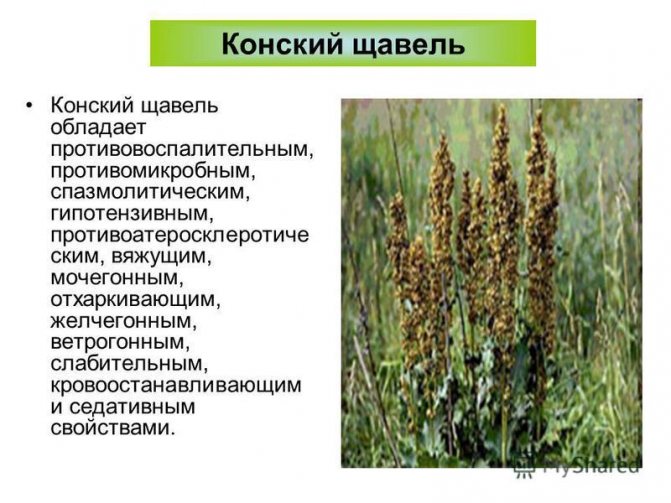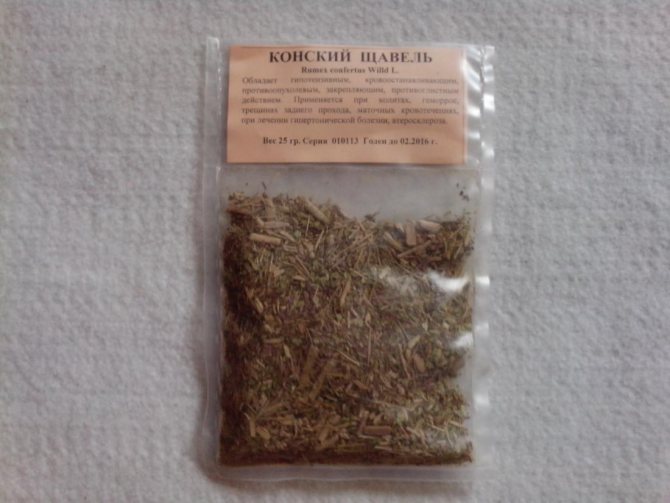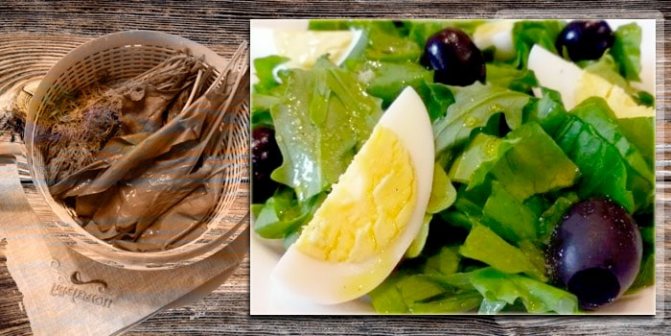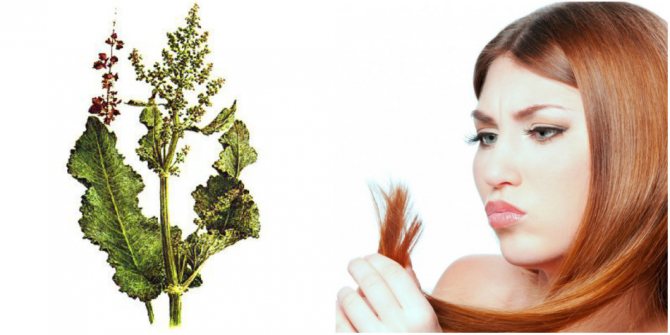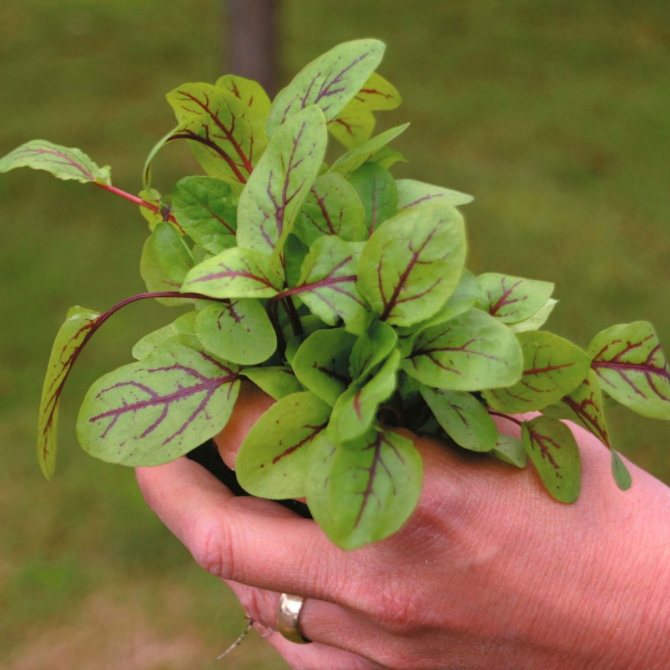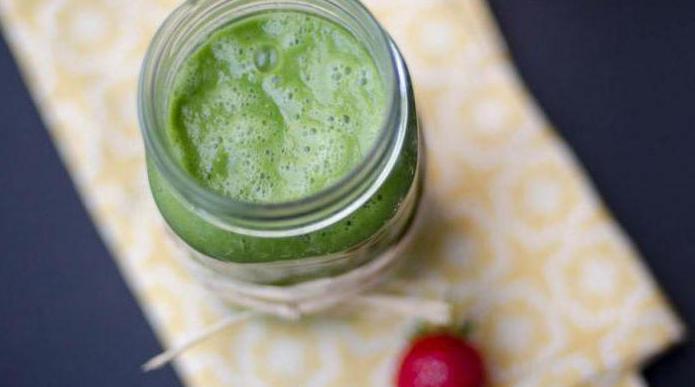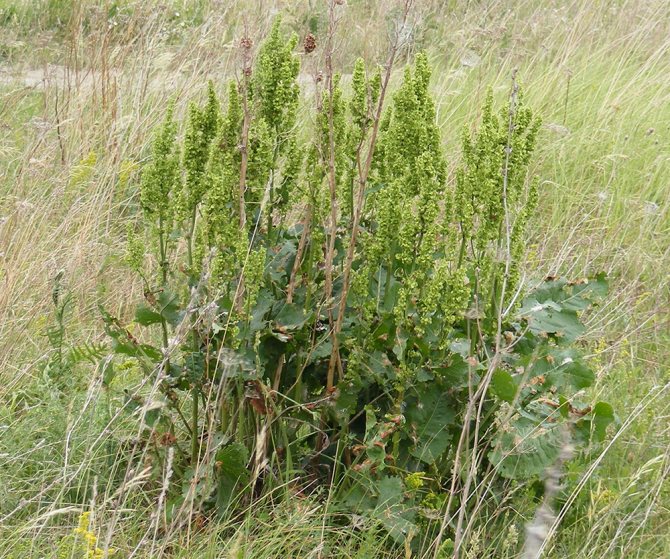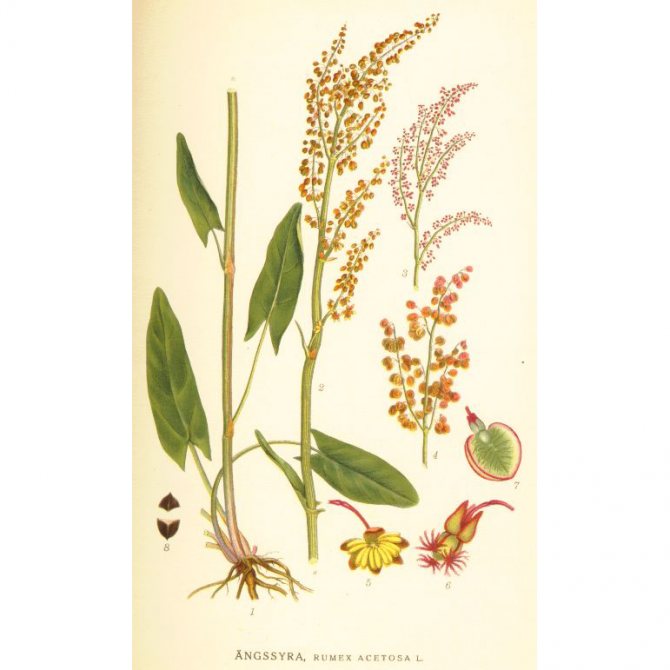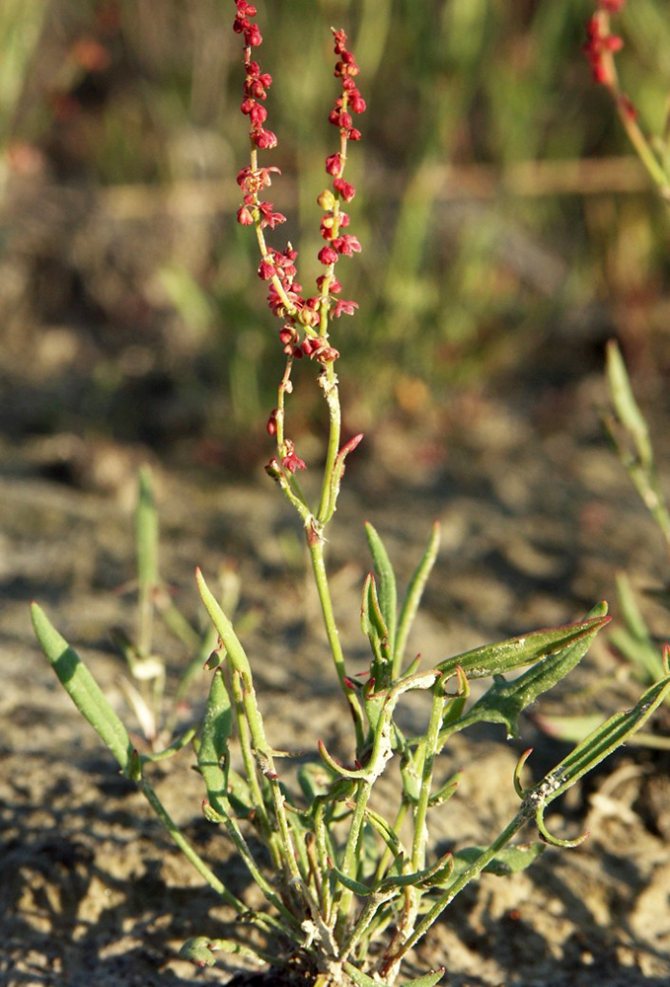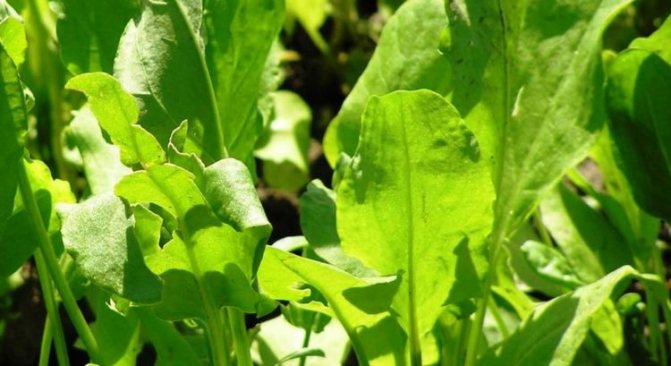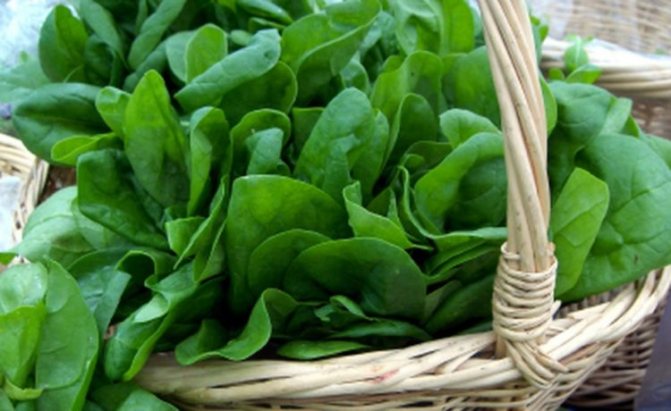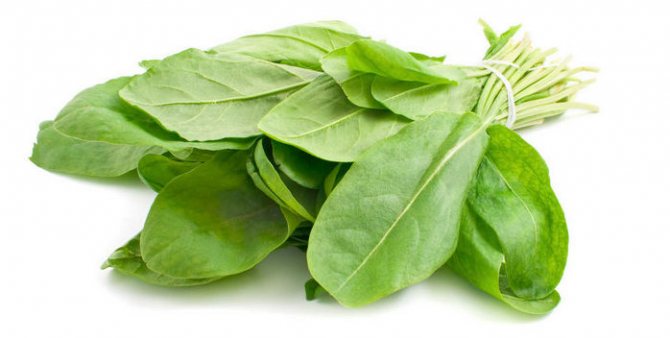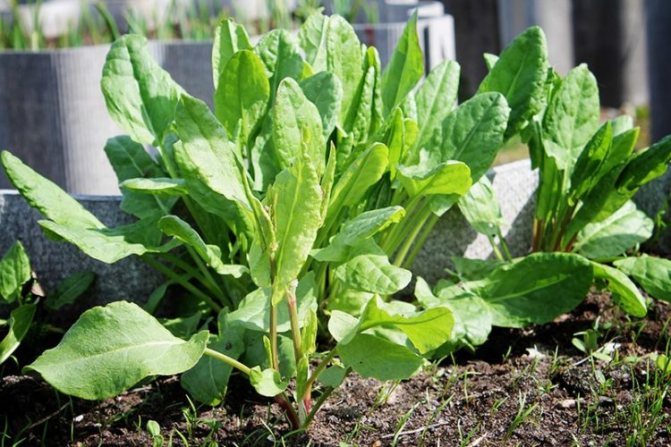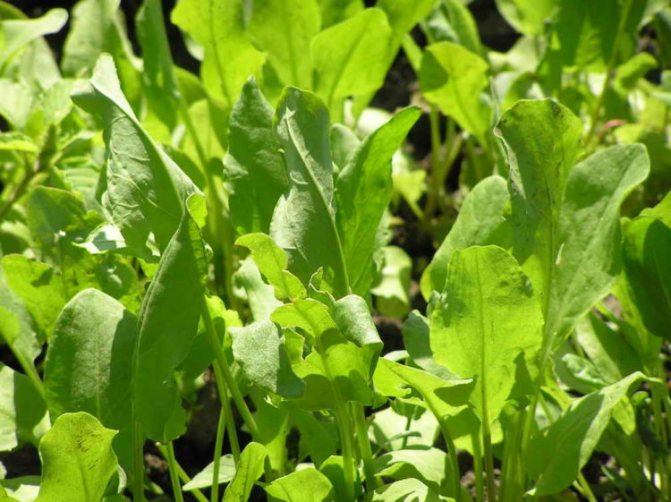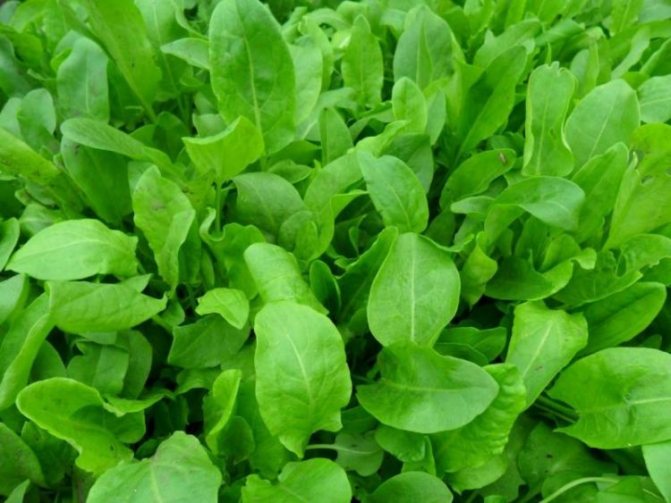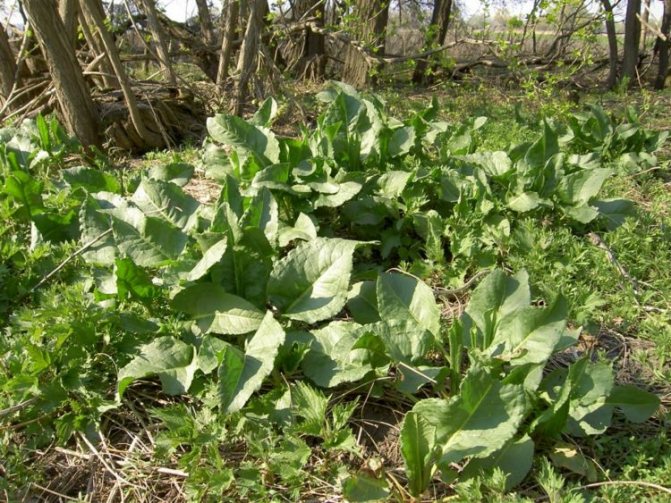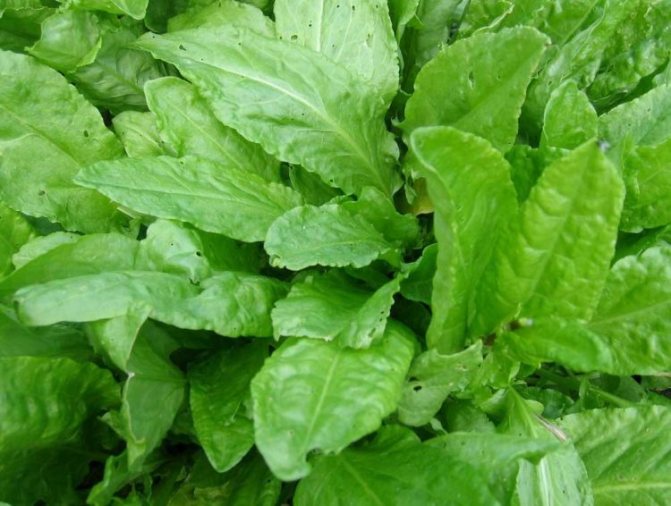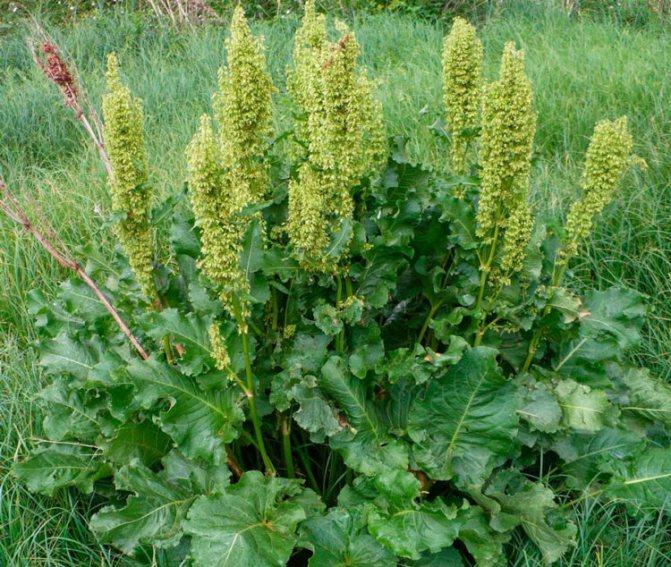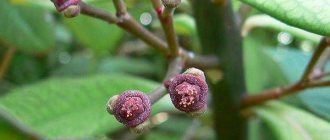On your own summer cottage, you can grow a huge number of plants. One of the most popular and favorite among summer residents is sorrel. He is unpretentious and has a fast growth. Sorrel is very easy to breed and easy to care for. It can be grown by a summer resident who does not have experience in performing agricultural work. But there are still secrets to successfully growing a plant that allow you to get especially generous yields.
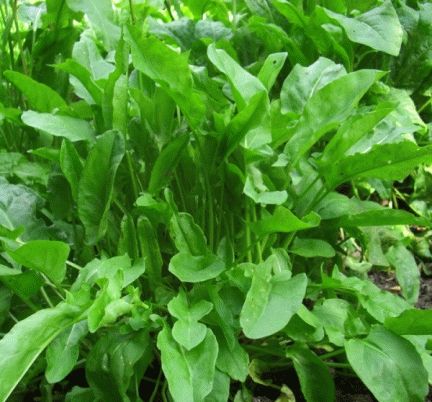
What it is?
Botanical Description - Annual or Perennial?
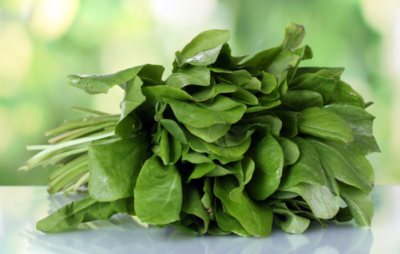

Sorrel is a perennial herb from the buckwheat family. Its root system is fibrous, the furrowed stem reaches a height of 30-100 cm. The leaves are arrow-shaped, alternate. Other names:
- sorrel;
- oxalis;
- sour sour;
- sour.
Since sorrel is one of the first to appear in the garden, in another way it is called the spring king.
Is it a vegetable or a herb?
Sorrel is a perennial herb, can grow in one place for several years. It is used as a feed for livestock, as a spice in various dishes, as a medicinal plant.
Important!
Absolutely all parts of this plant have a sour taste.
What it looks like: a description of the appearance and a photo
Below is a description of the leaves and what base they have, it tells about the seeds and what they are, and also briefly describes the flowers.
- Leaves. Arrow-shaped leaves grow upward, attached at the bottom with long petioles. They are deep green in color, have a distinct central vein. The leaf can reach a height of 20 cm.
Perhaps it was the shape of the leaves that caused the Latin name of the sorrel genus - rumex, which means "spear" in translation. - Seeds. After flowering, sorrel forms seeds. They are small triangular brown peas. They appear in August or September.
- Flowers. Sorrel flowers are collected in cylindrical panicles, can be of different colors: pink, red, yellowish.
Varieties
How to treat sorrel from green bugs
There are no less than 200 different varieties. But few are used today. Among the popular among gardeners, the following varieties can be distinguished:
- Sorrel Belleville - refers to mid-season plants. The foliage is large, oblong-ovoid in shape, of bright green color. In structure, the leaf is fleshy, mostly smooth, may be slightly bubbly, no more than 15 cm in length. The vegetable tastes almost non-acidic. Has a raised, spreading rosette, medium long thick petioles. The Belvian variety is immune to frost and disease;
- Large-leaved sorrel - a productive early variety. Standing socket, light green foliage. The vegetable is not launched into arrows, resistant to frost;
- Malachite - medium early, it takes up to 50 days to ripen. The foliage is smooth, the edges are wavy, the petioles are long. Leaves are slightly acidic to taste;
- Broadleaf sorrel - leaf plate is ovoid, medium and large, green in color. The foliage tastes tender, moderately acidic. A fruitful, frost-resistant species that is immune to shooting;
- Spinach variety - differs in large, erect leaves, medium early.The rosette is loose. There is a slight blistering, the color of the foliage is dark green. Slightly acidic in taste. The product is high in vitamin C;
- Emerald King - perennial vegetable, frost-resistant. It belongs to the early varieties, the ripening period is 40 days. The foliage is smooth, slightly acidic, delicate in taste. During the season, it is possible to collect at least 5 kg of greenery from a square meter. If you cover the beds for the winter, you can get the earliest products from the second year;
- Dull sorrel Is a perennial herb with a strong root system and a high stem. The foliage is arched or drooping in the middle. Seeds planted in the ground begin to germinate at +1 degrees. The foliage plate is flat, shiny, the shape is oblong-ovate. The ends of the leaves are blunt or weakly sharp. Suitable for hybridization with other varieties;
- Common sorrel - also known as bloody. Herbaceous plant, low, has a thin stem, maroon color. The foliage has an interesting lemon green color. It is considered one of the most popular varieties used in nutrition. The veins of the plant have a red-purple color characteristic of summer, which explains the second name of the vegetable. Outwardly, it resembles spinach, the foliage is in the shape of a spear, its length can reach 14 cm;
- Sanguine - is considered an early variety. Has an upright outlet, no more than 40 cm in height. The foliage is rather large, oblong-ovoid in shape. The leaf is green, may be slightly bubbly, the veins are red in color. Slightly sour, juicy leaves to taste. Frost-resistant, does not require special care, it is recommended to plant in open ground. Similar in characteristics to the cereal used in Western Europe to fight cancer cells;
- Sorrel Sparrow - a low perennial plant. Starting from the root, several leaves grow, can be erect and curved. Branching occurs at the top of the stem. Depending on the region, the plant may also be called small sorrel. The leaves can have different diameters and shapes. Basal leaves are spear-shaped, for stem leaves a truncated form is characteristic.
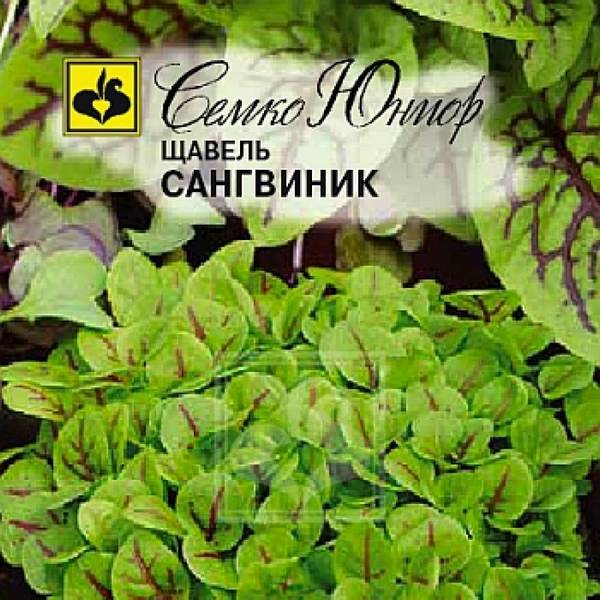

Sorrel Sanguine
Origin story
For the first time, residents of Western Europe began to taste sorrel leaves. References to this plant as an edible vegetable crop date back to the 12th century. The Greeks and Romans used it for both culinary and medicinal purposes.
In Russia, sorrel has long been considered a weed. And only since the 18th century it has not only been used as a medicinal herb, but also used for food. It is assumed that the name "sorrel" comes from the Slavic name "cabbage soup", because it is in this popular soup that green sorrel leaves are most often put.
Advice
In Russia, even a holiday dedicated to sorrel has appeared. It was called "Martha - green cabbage soup" and was celebrated on May 15. It was on this day that the hostesses began to cut the first juicy greens and cook sorrel soups.
Differences
From spinach
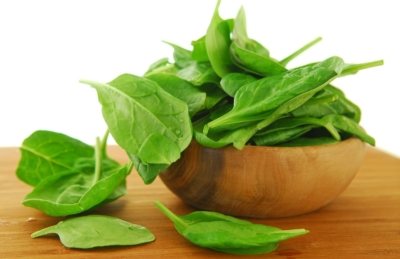

Sorrel and spinach are very similar plants. But they have two main differences.
- Sorrel has a sour taste, spinach has a neutral taste with a slightly noticeable bitterness.
- They have different leaf shapes: for sorrel, the leaves are pointed or rounded, smooth, light green, and for spinach they are round, wrinkled, dark green.
From rhubarb
Sorrel and rhubarb are also related plants. They differ in the number of stamens:
- the sorrel has 6;
- rhubarb has 9.
Rhubarb fruit is a nut with three sides. In their action, these plants are very close to each other, but sorrel has a more pronounced sour taste.
Use of sorrel
Young sorrel leaves have an increased concentration of citric and malic acid, contain vitamin C, potassium, iron and other useful components. That is why sorrel is recommended to be consumed raw. But many chefs use it in food preparation as well.Green borscht, filling for pies and pies, green mashed potatoes or an element of salads - sorrel can be used everywhere. In addition, many canned sorrel, because it is able to retain its beneficial properties even during heat treatment. Sorrel is also used in medicine. It is used as a choleretic and hemostatic agent.
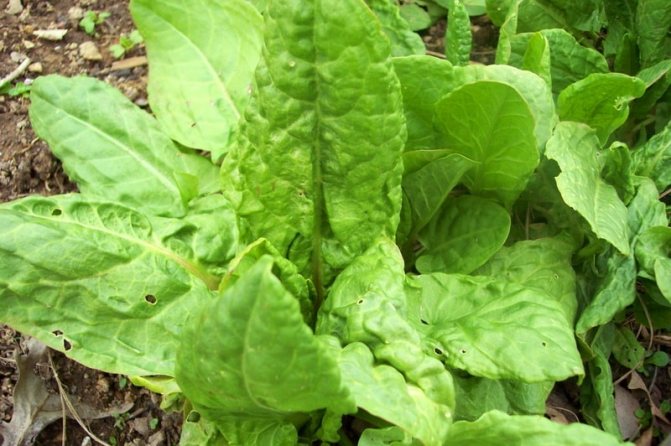

Interesting Facts
Below is a list of interesting historical facts about common sorrel.
- In France, sorrel, along with carrots, is considered a national vegetable crop.
- The plant contains a lot of vitamin C. During the First and Second World War, soldiers were advised to chew sour leaves to replenish this vitamin in the body.
- It has been observed that the milk of cows chewing sorrel in the field sours faster.
- Sorrel is beneficial for people with low hemoglobin levels, as the ascorbic acid it contains helps the absorption of iron.
- Until the 16th century in Russia, this herb was not eaten, considering it a weed. And at first it was called not “sorrel”, but “meadow apple” or “wild beet”.
Use in landscape design
The original red-green leaves look especially impressive in combination with a stone. Therefore, they are planted on alpine slides, in rockeries, along the edge of mixborders or along garden paths as a curb. They will find a place for them both in the usual, classic flower beds, and in the now fashionable pharmaceutical gardens, where not only seeds of medicinal plants are planted, but also other exotic plants.
Decorative sorrel is versatile, therefore it is gaining more and more popularity, both among landscape designers and gardeners.
Benefit and harm
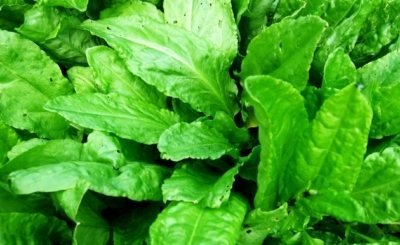

Sorrel benefits:
- has a wound healing effect;
- useful in diseases of the heart system;
- it is used for skin itching, rashes, allergies;
- has a hemostatic effect;
- is a source of vitamin C and oxalic acid;
- eliminates the unpleasant consequences of menopause;
- improves liver function;
- slows down the aging process, strengthens the immune system;
- in folk medicine it is used as a remedy against tumors of a different nature;
- has a positive effect on the digestive system.
Sorrel harm:
- with heavy use, it can be harmful to people with kidney and gallbladder diseases;
- hinders the absorption of calcium, which can be the cause of the development of osteoporosis;
- large amounts of oxalic acid can be harmful to the body.
We suggest watching a video about the benefits and dangers of sorrel:
Horse sorrel application in folk medicine. Horse sorrel infusion: how to make and use?
The main forms of folk remedies with thick sorrel are water and alcohol tinctures, as well as a decoction from the dried root.
RECIPE: Tincture of horse sorrel root in water. Looking for:
- dried rhizome - 5 g
- boiling water - 200 ml
- The plant component should be poured into a glass dish and poured with boiling water.
- Put the dishes in a saucepan with boiling water and simmer for 30 minutes.
- The shelf life of the tincture is 72 hours.
IMPORTANT: Tincture with this ratio of herbal component and water acts as a laxative. To achieve the fixing effect of sorrel roots, take 2.5 g per glass of boiling water.
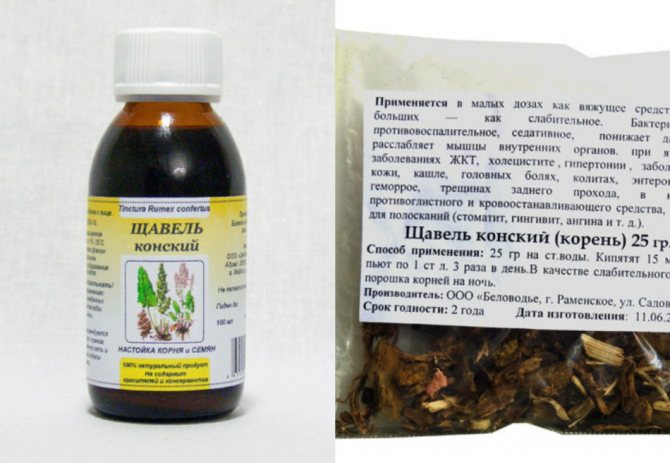

A medicinal alcoholic tincture is prepared from the roots of horse sorrel.
RECIPE: Tincture of horse sorrel root in alcohol. Looking for:
- dried root - 4 tbsp. the spoon
- alcohol 70% - 200 ml
- The plant component in glassware is poured with alcohol, corked and left in a dark place for 2 weeks.
- The dose is calculated in drops, if necessary, dilute them in 10 ml of water. For example, with rheumatism, 15 drops of tincture are drunk 2-4 times a day.
RECIPE: Decoction of horse sorrel root. Need to:
- dried root - 5 tbsp. spoons
- water - 1 l
- The herbal preparation is placed in a saucepan, poured over with water and put on fire.
- After boiling, it is boiled for another quarter of an hour, allowed to cool and poured through a fine sieve or cheesecloth.
- This broth is used for gum disease (periodontal disease, gingivitis, stomatitis). They rinse their mouth.
- For colds, a decoction of 1 tbsp is used as an antiviral and expectorant. tablespoons of horse sour roots in a glass of water. The amount of broth is divided into three servings and taken throughout the day.
- Also, this broth is suitable as an antispasmodic agent for painful periods.
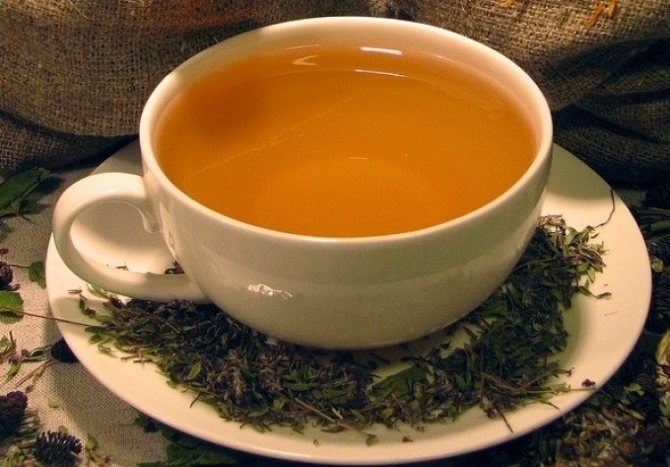

Decoction of dried horse sour root.
In a broth, 100 g of dried rhizome of thick sorrel per 3 liters of water, diluted in a bath of standard sizes, bathe children with diathesis.
How is it used?
In cosmetology


The beneficial properties of the plant are widely used for cosmetic procedures:
- healing of skin inflammations;
- care for oily and problem skin (acne, acne, freckles);
- the juice is used to add to the tooth rinse;
- reduces bleeding gums.
In folk medicine
The plant is widely used in traditional medicine in different countries:
- sorrel decoctions have a diuretic effect and remove edema;
- prevents the appearance of scurvy;
- improves appetite;
- used to treat various skin diseases;
- astringent broth is used for dysentery.
In cooking
- Young green leaves can be added to various cocktails.
- It goes well with vegetables and other herbs in salads.
- An indispensable addition to cabbage soup, borscht and okroshka.
- It is widely used in various baked goods: pies, juices, dumplings, tortillas, etc.
- Sorrel is used both for canning and for freezing for the winter.
Beneficial features
Sorrel - planting and care in the open field
Few of all sorrel varieties are considered healthy. For each continent, its own variety is considered useful; in Russia it is sour sorrel, which is grown in most regions of the country. The popularity of the plant is due to its useful composition. All the benefits lie in the deciduous part, it is it that it is good to use in cooking. With an emphasis on beneficial properties, it is worth noting that the content of vitamin C in this vegetable is capable of replenishing the daily norm necessary for the body.
The foliage of the herbaceous vegetable is rich in vitamin E, PP, K, biotin (vitamin H). Sufficiently high content of vitamin A (beta-carotene), riboflavin and thiamine (vitamin B group). Also, the composition contains a sufficient amount of minerals:
- Iron;
- Phosphorus;
- Potassium;
- Magnesium;
- Sodium;
- Sulfur;
- Chlorine;
- Iodine;
- Manganese;
- Copper;
- Zinc;
- Fluorine;
- Calcium.
It is not only the presence of vitamins and minerals that makes sorrel leaves useful. They are also targeted for their natural proteins, fats, carbohydrates, organic acids, ash and fiber. Although sorrel is a champion among vitamin cultures, not everyone can benefit from its healing properties. There is a list of people for whose body sorrel is harmful.
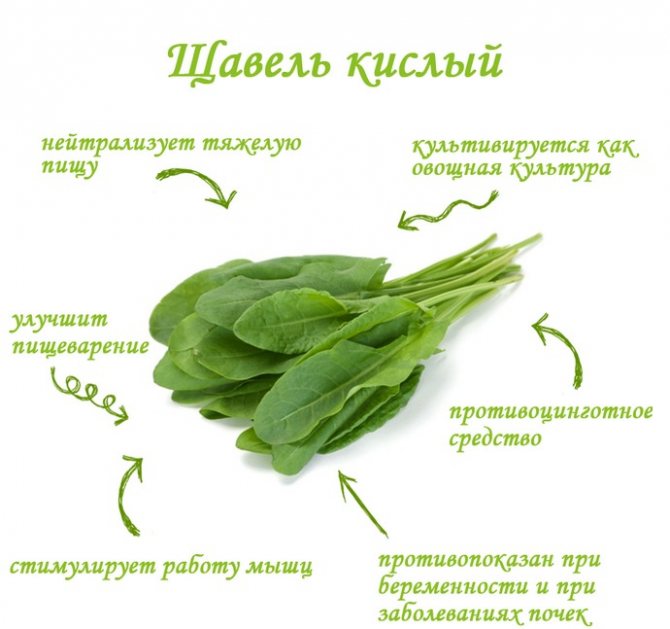

Why sorrel is useful
First of all, the plant is contraindicated in the presence of disruptions in water-salt metabolism. The acid contained in the product often causes the formation of kidney stones, causes inflamed processes in the tissues of the joints, which can complicate the course of gout, rheumatism, arthritis, etc. Sorrel is not recommended for people with stomach problems.
So that the plant does not harm the human body, a step-by-step algorithm should be used to neutralize the negative impact:
- First of all, you cannot cook a vegetable in cast iron and aluminum dishes. The acid in the composition reacts with these metals, which leads to the accumulation of toxins in the cooked dishes;
- Secondly, the use of foliage no more than 2 times a week will not provoke an exacerbation of existing diseases. In this case, the body will receive the required amount of nutrients.
How many varieties and types does it have?
There are 150 known species of sorrel, about 70 of them grow in Russia, only a few are used by humans, the rest grow in the wild. The most famous are the following types:
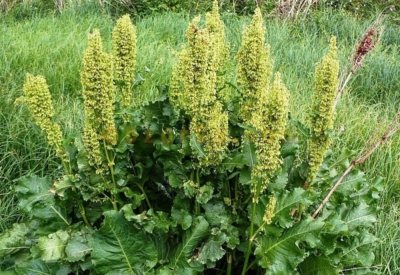

- horse sorrel;
- sour or common sorrel;
- passerine or sorrel;
- water;
- curly;
- seaside;
- dull-leaved;
- spinach.
Many varieties of sorrel have been developed. Some of them have a more sour taste, while others have less sourness, they differ in leaf shape and size. The most famous varieties of common sorrel are:
- Altaic;
- Lyons;
- Belleville;
- Malachite;
- Emerald King;
- Large-leaved;
- Champion;
- Spinach.
Horse sorrel for treating strawberries from diseases
Summer residents and gardeners who grow strawberries can take a note: horse sorrel can save berries from parasites. A spray agent is being prepared from the leaves of the plant:
- leaves in an arbitrary, as much as possible, finely torn, folded into a bucket and filled with water
- the tincture is kept for 10 - 14 days
- the ready-made infusion should be poured over the strawberry bushes so that it hits the leaves
Whitefly, which harms the berry harvest, will not covet strawberries sprayed with horse sorrel.
Growing rules
In the open field in the garden
Sowing a crop in the ground is best done in early autumn or late winter. In the spring, you can also do this, but then you will wait longer for the harvest. Sorrel grows well both in the shade and in the sun.
- It is necessary to carefully dig up the planting site, remove weeds.
- Seeds are sown in furrows to a depth of 3 cm. When planting, add humus and sawdust.
- For fertilization, use mineral fertilizing, superphosphate, compost.
- If seedlings were frequent, they are thinned out.
- Watering should be frequent and abundant, the plant loves water.
Important!
In fertile soil, sorrel grows in one place for up to 6 years, and in poor, poor land - up to 4 years.
At home
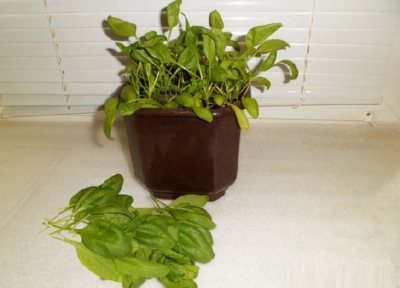

The culture grows well at home, so that in winter you can please yourself and your loved ones with fresh greens. Sorrel tolerates cool weather well, so it can be grown at a temperature of +4 - + 20 ° C on the balcony. The container must be at least 20 cm deep for the roots to grow well. The main thing is to prevent the soil from drying out, periodically apply mineral fertilizing and make sure that the plant receives enough sunlight.
How to grow sorrel from seeds outdoors
Sorrel
Sorrel grows everywhere in the meadows. But the leaves are small and edible only in spring. High-quality sorrel is not so sour, it is larger and can be cut several times all summer. Although it tastes best in spring and autumn.
This plant is cold-resistant - it germinates calmly at + 3-4C.
Seat selection
First you need to choose a suitable location. Since sorrel can grow up to 5 years in one place. We choose a place in partial shade with a soft evening sun. The soil should be fertile, sorrel grows best of all on loams, it is not afraid of acidic soil, so there is no need to lime it. It is impossible for water to stagnate in the area with sorrel.
It is advisable to prepare a bed for sorrel in the fall. Loosen the ground with the addition of humus and ash.
Sorrel is sown at different times:
When is the best time to plant sorrel?
- Seeds can be sown before winter, around November in the Urals, so that the soil is already frozen and the seeds cannot germinate in winter.
- When sowing in spring, do it early, in April. With both of these methods, it will already be possible to taste fresh leaves in the summer. But you can cut the crop only once a year of sowing.
- In summer, you can sow sorrel in early July, in the beds after radishes, lettuce, onions. When planting in summer, we will harvest the crop only next year.
Sowing
There is no need to make a large bed for sorrel. Two square meters can yield a very good harvest.
- I usually make transverse rows with a distance of 20 cm.
- I sprinkle the seeds often, you can soak them before sowing.
- If sown dry, seedlings appear in two weeks. And if you cover the bed with a film, then the sprouts will appear in 5-6 days.
- After the emergence of three or four leaves at the shoots, I thin them out. I leave a distance between shoots of about 10 cm.
Sorrel care
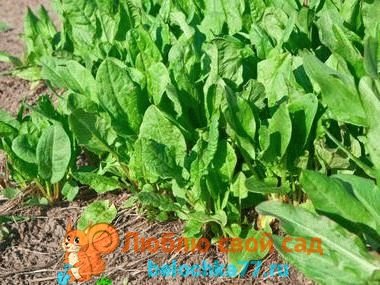

Early greens in spring come in handy!
- The main care for young crops is watering. Whether in the spring or in the summer. An adult plant is also very fond of water.
- If you dry the ground, then the sorrel quickly releases flower stalks.
- Important points are loosening and weeding. To reduce this work, after each watering-loosening it is necessary to mulch the plantings with sorrel.
- It is better to cover the roots for the winter with compost, humus, rotten sawdust.
- After each mass cutting of leaves, the sorrel must be fed with infusion of grass, nettle or mullein (diluted 1 to 10) and watered abundantly.
- In the spring, it is useful to loosen the aisles with the addition of ash and humus to stimulate the growth of young leaves. Then pour well and cover with foil. Then the leaves will grow faster.
- We collect sorrel leaves in the morning, so they are juicier. You can cut them off with a knife, leaving 5 cm or just pluck them out. We do not touch the small leaves in the middle so that they grow further. When harvesting, you cannot pull on the leaf, because you can pull out the entire plant by the root.
- A month before frost, they stop cutting off the leaves so that the plants get stronger before winter.
Sorrel diseases and pests
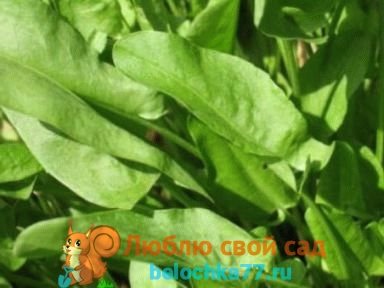

Downy mildew
- spots with a gray bloom appear on the back of the leaves. To combat the disease, the leaves are sprayed 10 days before cutting with Bordeaux liquid. Or treat phytosporin with a biological product. The instructions say that you can use the product on the day of processing, there are no poisons there.
Rust
- when affected by this disease, small yellow-brown spots appear on the leaves and stalks of sorrel, and dark spores appear on them.
Sorrel aphid
- sucks juices from the plant. It is impossible to process the leaves, as they are then eaten. You can water in the fall after cutting with some infusion of bitter, pungent herbs - tomato or potato tops, dandelions, garlic. Also, aphids do not like sprinkling ash on the leaves. Or treat planting in the fall with a biological product against phytoverm pests.
Sorrel leaf beetles and larvae and sawfly caterpillars
... Spraying with infusions of garlic, tomatoes, nightshade helps well.
You will find many different recipes in the article "".
With good care, a fairly rare planting, sorrel is rarely affected by diseases. It is necessary not to run it wildly, to change the place in time.
In order to sow their sorrel seeds again in a new place, they leave several plants for seeds in the spring. They don't have their leaves cut to get full seeds. Sorrel begins to bloom in May, and the seeds ripen in early to mid-July. The panicles turn brown. They need to be cut off and dried for another ten days in brooms. Then the seeds are threshed. They simply rub the brooms in their palms and blow out the debris. The seeds are stored in a dry place for up to 4 years.
Sorrel varieties with photos and descriptions
They differ in early maturity, leaf shape and color, acidity. Although the amount of acid also depends on the composition of the soil and care.
Ordinary garden
- the most common variety. The leaves are spear-shaped, dark green, on a thin, long petiole. The variety is very winter-hardy, fruitful.
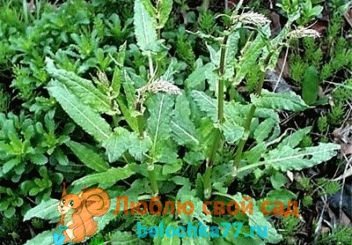

Common sorrel
Large-leaved
- early variety. It has large, light green, almost oval leaves. The taste is medium acid, good. High productivity and frost resistance.
Variety "Large-leaved"
Altaic
- leaves are smooth, pointed. In spring, they are green, and then turn reddish with a long petiole. The socket is straight, high. They tolerate frost well. The taste is sour and moderately sour.
Broadleaf
- drought-resistant variety. Fruitful, pleasant slightly acidic taste. Thin large leaves. Winters well.
Variety "Shirokolistny"
Lyons
- large, thick, ovoid leaves. Green with yellowness. Thick, low petioles. The variety is tasty, fruitful, but it can freeze slightly.
Sorrel can develop in one place for four or five seasons, so you need to provide the plant with the necessary amount of nutrients. Sorrel leaves contain some trace elements, oxalic and malic acids, vitamins and mineral salts.
The plant can withstand sudden changes in temperature, winters well. Its seeds begin to germinate when the soil temperature rises to 2 degrees Celsius. The most favorable conditions for the development of culture are considered to be shaded areas with well-moistened soil, but an increase in the yield can be obtained only with proper feeding of sorrel.
For the entire period of sorrel cultivation on the territory of one site, three-time feeding of the culture is carried out. The first time this is done in the autumn when preparing the soil for the culture. The second time in the spring of every year, the third - after the harvest of the greenery.
The culture receives the bulk of the nutrients after preparing the soil for sowing seeds. To do this, in the fall, after harvesting the previous crop, digging the beds is carried out with the simultaneous introduction of 15 grams of ammonium nitrate, 10 kilograms of organic matter (humus or compost) and 15-18 grams of potassium salt. All of these substances are calculated per square meter of usable area. Fertilizers are thoroughly mixed with the ground, and in the spring, just before planting, 15-20 grams of urea is applied per the same unit of area.
As we have already said, the feeding of sorrel in all subsequent years is carried out in the spring. Before enriching the soil with nutrients, you need to remove dried leaves and stems from the last year from the site. Due to the fact that the greens ripen quickly, organic substances are used for feeding:
- two buckets of humus or compost per m2 of the garden. Fertilizers are buried in the soil between rows;
- a solution of liquid mullein mixed with water in a ratio of 1 to 7.
Another top dressing is carried out after harvesting the crop. Note that the first cut of greenery is carried out when the leaves reach a height of 8-10 centimeters, and all subsequent ones when 6-8 leaves are formed on the plant. You need to trim the sorrel carefully so as not to accidentally remove the growth point of the culture. Sorrel is fertilized with mineral fertilizers, the main component of which is nitrogen. In wet weather, top dressing is simply scattered over the area in a dry form, but if the weather is dry, then the active ingredient must be diluted with water in the required proportions.
In August, sorrel plantations are fed with fertilizers containing in their composition a significant dose of phosphorus, but it is not recommended to introduce wood ash. The fact is that ash reduces the acid reaction of the soil, because sorrel develops better on acidic soils. Limit phosphate fertilizers to prevent flowering.
Sorrel is a herbaceous perennial plant from the buckwheat family. It belongs to those types of greenery that can be cut one of the first in the spring. Sorrel contains a large amount of various vitamins, malic and citric acids, as well as mineral salts.
Being frost-resistant, its seeds germinate at a temperature of only 2-3 degrees above zero. The most favorable conditions for the growth of sorrel are moist soil and partial shade. In order to get a good harvest, sorrel needs feeding. The type and composition of the fertilizer depends on the season and the reason for which it is used. And now let's take a closer look at the question - how to feed sorrel in different situations.
Diseases and pests
The main diseases of sorrel:
- mildew;
- gray rot;
- white spot;
- rust.
Pests:
- leaf beetle;
- bear;
- wireworm;
- winter scoop;
- sorrel sawfly;
- aphid.
Prophylaxis
Preventive measures are:
- correct agricultural technology;
- digging the beds in the fall;
- weed removal;
- cleaning plant residues from the beds;
- planting near the beds with pyrethrum sorrel (Dalmatian chamomile) or marigolds;
- timely phosphorus-potassium fertilizing.
Fight
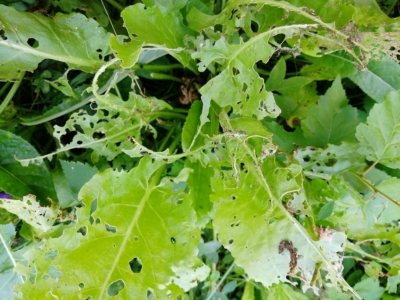

Various methods are used to combat pests and diseases:
- plants are pollinated with hexachloran, only after cutting the foliage;
- spraying with Bordeaux liquid;
- spraying with anabasine sulfate or nicotine sulfate;
- processing with folk remedies: garlic soap solution, ash and tobacco dust, ammonia, lime, eggshells, infusion of onion peels.
All chemicals are applied post-harvest to reduce the risk of chemicals being ingested.
Horse sorrel soup
A delicious lean soup is prepared from horse sorrel, for which you need:
- horse sorrel - 200 g
- lentils or bulgur - 200 g
- potatoes - 3 pcs.
- onion - 1 pc.
- greens (dill, parsley, cilantro)
- salt pepper
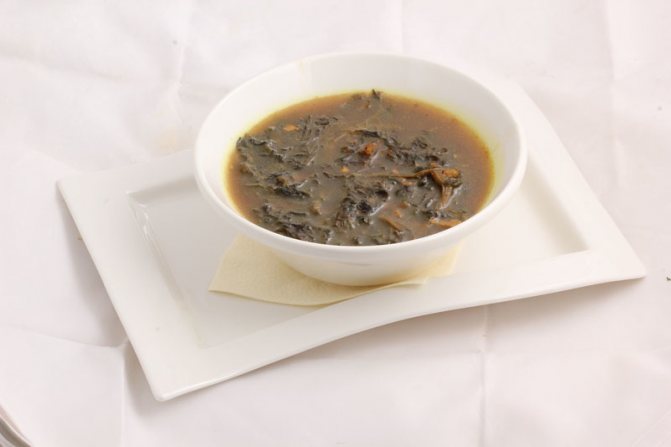

Soup with horse sour.
- For this soup, horse sorrel is boiled for 20 minutes after soaking and slicing.
- Cook cereals - lentils or bulgur in a separate saucepan until cooked.
- Peeled, washed and diced potatoes are sent to a pot of water to cook.
- While the potatoes are boiling, the onions are sautéed.
- Grits, aveluk and sautéed onions are added to a saucepan with almost finished potatoes. Cook together for 3 minutes.
- Soup with chopped herbs is served.
When and how to harvest?
You can start harvesting sorrel in May or early June. Leaves that have reached a length of 8-10 cm are pinched off (or better, cut with a sharp knife) together with the petiole. Leave a distance of at least 5 cm from the ground. Fresh leaves grow every 18-20 days, so they can be harvested 3-4 times during the whole season. Harvesting is done in the morning, after the dew dries. If the leaves are harvested early in the morning, dew will cause rot.
Advice
Leaves harvested in the middle of the day will wilt faster.
Plant features
Sorrel, which has been successfully grown from its seed, is a perennial plant that can enjoy its sour taste all year round. He is not afraid of low temperatures. Sorrel rises with the appearance of the first rays of the sun, and already in mid-May it is able to give the first full harvest: leaves up to 10 cm long are simply cut off and used at individual discretion. After 15 days, the plant grows back completely. The last harvesting period is the middle of summer: until that time, the plant will accumulate a lot of acid, acquire coarseness. Culture becomes tasteless, and it is undesirable to eat it.
Chemical composition
The leaves and trunk of sour sorrel contain
- vitamins B, C, E, K, PP;
- organic acids (oxalic, citric, malic);
- carotene;
- anthraquinones (chrysophanol, emodin, fiscion);
- phenolcarboxylic acids: caffeic, protocatechinic, gallic;
- rutin;
- flavonoids (hypericin);
- vitexin;
- mineral salts of magnesium, iron, calcium, potassium.
Sorrel roots contain:
- chrysophanic acid;
- multinuclear aromatic compounds (neposide, nepozid, rumycin);
- tannins;
- anthraquinones (rhein, aloe-emodin);
- vitamin K.
What it looks like: a description of its appearance
Sorrel has a straight stem up to one meter in height, and ends with a paniculate constellation. The flowers are small and inconspicuous, with triangular fruits. In the lower part, the stem is reddish. The leaves are very soft and juicy, at the base they are long-petiolized, and at the top they are sessile. Leaf blades up to 20 cm.
The fruit is shiny, with brown polka dots. All parts of the plant have a sour taste. Achenes triangular up to 1.7 mm. Sorrel root is distributed in several layers.
How to distinguish horseradish from horse sorrel?
Due to the similarity of plant leaves, gardeners often cannot figure out what is growing on their site, horseradish or horse sorrel. While both are very beneficial, they have very different tastes and uses. Therefore, it is fundamentally important to distinguish them.
IMPORTANT: Horseradish and horseradish are plants from different families. The first belongs to the Cabbage family, the second, as is already known, to the Buckwheat family.
- Before an unidentified plant blooms, it is difficult to identify it. But experienced gardeners believe that the shade of horseradish leaves and horse sorrel is somewhat different. In the first, it is lighter.
- You can also taste the leaves. In horse sorrel, they are slightly bitter; in horseradish, they have a scalding, pungent taste.
- When the plant blooms, the difference becomes apparent. Sorrel blooms with thyrsus of greenish-yellow flowers, horseradish - with clusters of flowers with 4 white obovate petals.
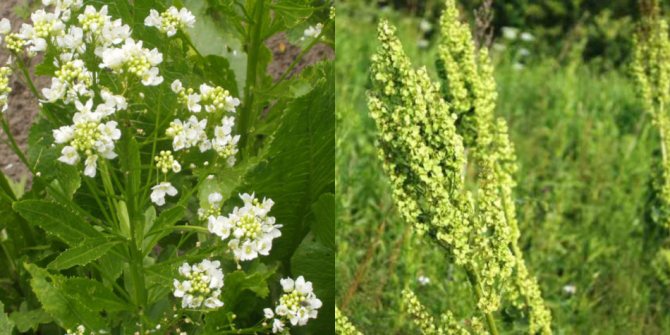

Blooming horseradish and horse sorrel.
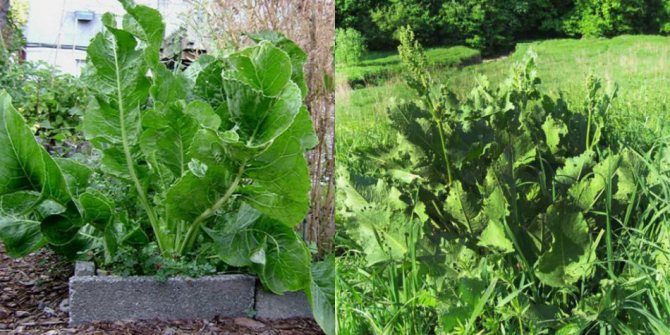

Horseradish and horse sorrel are similar in appearance.
Contraindications
The benefits of sorrel for the body are significant. But, like any other product, it is not recommended to eat it for people with the following diseases:
- gout;
- urolithiasis disease;
- kidney inflammation;
- increased acidity of the stomach, gastritis, ulcers;
- during pregnancy, when pathologies of any kind are present. If it proceeds without complications, then the use of a small amount of young leaves will bring more benefits to both the mother and the baby.
Effects on the skin
Many people know what vitamins sorrel contains, so it is very often used to treat fungal diseases of nails and skin, as well as eczema. It is an excellent cosmetic care product. With the help of gruel, you can lighten the skin, and make freckles and age spots less noticeable. Sorrel can also be used to combat acne and improve oily skin.
The greatest benefits of sorrel will come from the use of fresh juice in lotions and leaf masks. The most popular recipes from it will be presented below.
- For aging oily skin, mix a tablespoon of chopped leaves with beaten egg white and a teaspoon of liquid honey. The prepared gruel is applied to the face and washed off after 15 minutes.
- If there is acne, then the point effect of the juice on the problem areas is useful. To do this, you need a cotton swab, which is moistened with the prepared lotion, and then the mass is pointwise applied to the acne. After 20-30 minutes, it is recommended to wash and rub your face with chamomile infusion.
- To remove age spots and lighten the skin, you need to chop the leaves of parsley and sorrel and mix them in equal proportions, add a small amount of kefir to get a uniform mass, and then apply it to the skin or problem areas for 15 minutes. Then you need to wash yourself with cool water. This mask is perfect for oily skin, as it perfectly narrows pores and removes excess subcutaneous fat.
Sorrel for the winter: video
Sorry for the winter: just add water!
<автор евгения="" степанова="" кандидат="" сельскохозяйственных="">
ORDER QUALITY AND CHEAP SEEDS AND OTHER GOODS FOR HOME AND COTTAGE. PRICES ARE BOTTLE. CHECKED! JUST LOOK FOR YOURSELF AND BE AMAZED HOW WE HAVE REVIEWS. GO >>>
Below are other entries on the topic "Cottage and garden - do it yourself"
- Growing radishes and sorrel in the SHADOW under trees: Radishes and sorrel in the shade ...
- Useful properties of quinoa and recipes with it: Quinoa grass will always help According to the recollections of many ...
- Requirements of vegetables for heat and light, watering and the length of the day: Vegetables - moisture-loving and drought-resistant, ...
- How to deal with the sorrel leaf beetle: Sorrel leaf beetle - measures and ...
- Transplantation of perennial vegetables - a table-reminder of predecessors: TRANSLATION OF PERENNIALS - WHEN AND ...
- We tame wild herbs and use them for cooking: What wild tarvas can you use ...
- Reproduction and transplantation of perennials: PERENNIALS IN AUTUMN: REPRODUCT, REPLOT End of September ...
Subscribe to updates in our groups and share.
Belleville
One of the first varieties bred specifically for growing in beds. The plant is perennial.
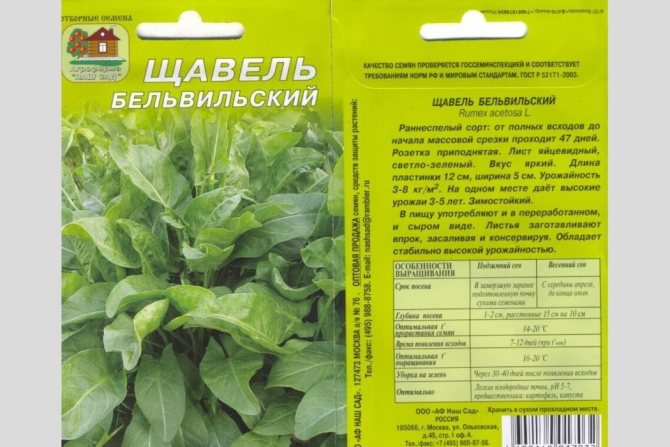

The characteristics of the variety are as follows:
- ripening period - 48-50 days, the variety is medium early;
- spreading and raised rosette of leaves up to 15 cm high;
- leaves are weakly or medium-bubbly, ovoid in shape, edge is even or slightly wavy, light green color;
- germination of seeds at a temperature of 6-8 degrees;
- seedlings appear in 1.5-2 weeks;
- yield - up to 7.3 kg per 1 sq. m.
The Belleville variety is quite popular due to its advantages:
- the possibility of early sowing;
- cold resistance;
- high content of ascorbic acid, carotene, B vitamins, valuable organic acids;
- stalk resistance;
- rapid regrowth of young leaves;
- excellent productivity;
- versatility of application.
Belleville sorrel can be eaten fresh, added to salads. The variety is ideal for canning, good for heat treatment - soups, baking fillings.
The ruggedness and excellent yields make Belleville Sorrel suitable for industrial cultivation.
Salad
In the spring, everyone suffers from vitamin deficiency and wants to somehow restore the lack of vitamins. Sorrel is one of the first to appear after winter, and it is an excellent tool for solving this problem.
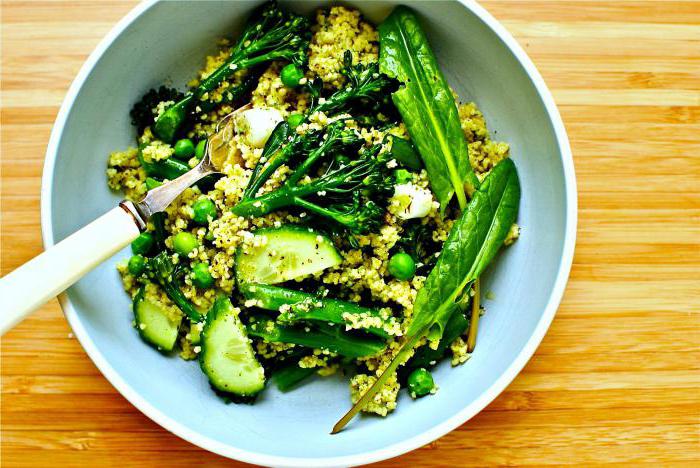

Ingredients:
- canned peas - 2 tbsp. l;
- sour cream - 2 tbsp. l;
- chopped sorrel - 1 cup;
- chopped green onions - 2 tbsp. l;
- eggs - 2 pcs.;
- red or white radish - 1 bunch;
- salt - 1 pinch;
- greens - 6 branches.
Preparation:
All prepared ingredients are mixed and seasoned with sour cream, after which the salad needs to be slightly salted and mixed again. It is recommended to consume the dish immediately.
Champion
The variety is perennial, the main characteristics are as follows:
- medium ripening times, mass cutting after 40 days;
- plant height - up to 40 cm, diameter - up to 30 cm, erect rosette;
- leaves are large and juicy, green, petioles are small;
- the leaves have an elongated oval shape, a smooth surface and a slightly wavy edge;
- pleasant slightly acidic taste of greens, delicate texture;
- yield - up to 7 kg per 1 sq. m.
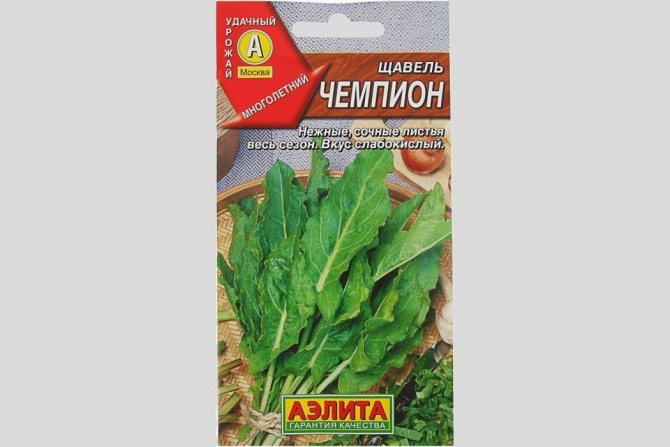

Sorrel Champion has the following advantages:
- tenderness and pleasant taste of greens;
- the possibility of summer and winter sowing, which ensures an early harvest for the next year;
- cold resistance;
- the possibility of growing in a sunny area or in partial shade;
- greens are rich in carotene, ascorbic acid and B vitamins;
- good productivity;
- versatility in application.
Champion sorrel is good fresh. Greens are added to salads, used to prepare first courses and side dishes. The variety is suitable for canning.

